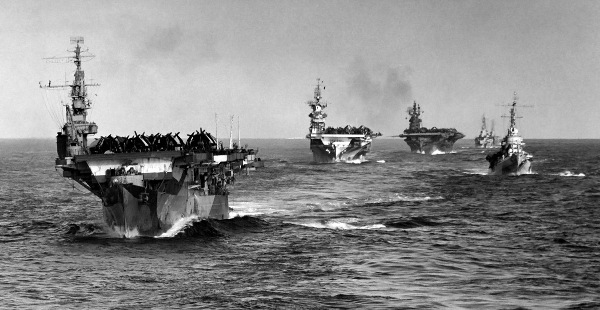 |
 |
 |
 |
 |
 |
BATTAGLIA NAVALE DI LEYTE
(23 - 26 OTTOBRE 1944)
NAVAL BATTLE OF LEYTE (23 - 26 October 1944)
 |
 |
 |
 |
 |
 |
 |
PROLOGO
- THE BEGINNING -
INCURSIONI PREPARATORIE (THE FIRST AIR INCURSIONS)
(TRATTO DA "LA GUERRA DEL PACIFICO" DI B. MILLOT, 1968)
Abbiamo visto come la Task Force 38 avesse già cominciato le incursioni che preparavano la grande invasione.
L'ammiraglio Halsey non aveva lasciato ammuffire la sua potente armata (vedere tavola qui sotto) e il 10 ottobre attaccò Okinawa e alcune altre isole dell'arcipelago delle Ryukyu, dove furono distrutte numerosi navi ausiliarie nonché 110 aerei.
L'11 ottobre l'aeroporto di Aparri, nel nord di Luzon, subi un violentissimo bombardamento con effetti estremamente devastatori, i cui risultati però erano ben poca cosa in confronto a quanto sarebbe accaduto più a nord. Infatti, l'isola di Formosa, posta più a nord delle Filìppine, costituiva un ideale punto d'appoggio per l'invio di rinforzi giapponesi; e la sua neutralizzazione divenne ben presto una necessità per il comando americano.
La terza flotta di Halsey si avvicinò a Formosa nella notte dall' I I al 12 ottobre e, prima dell'alba, le portaerei raggiunsero un punto situato 7° miglia a est della grande isola nipponica.
Alle 5.44 la prima ondata di aerei americani decollò e si diresse sugli
obiettivi prescelti, dando così inizio alla grande battaglia aerea di Formosa.
Aerei da ricognizione giapponesi individuarono la flotta americana e
l'allarme fu dato con tempestività sufficiente a consentire a numerosi
aerei giapponesi di decollare e di portarsi incontro agli assalitori.
Tutto
ciò di cui disponeva il comando nipponico in fatto di aviazione di riserva si trovava a Formosa, e gli americani dovettero affrontare più di
un migliaio di apparecchi nemici.
Per tre giorni si ebbero giganteschi combattimenti aerei e numerosi attacchi vennero sferrati dagli uni e dagli altri. Questa battaglia aerea, la più importante di tutta la guerra, terminò a vantaggio degli americani, perché le perdite furono incontestabilmente più pesanti per i giapponesi.
Infatti, più di 1000 aerei nipponici furono distrutti, una quarantina di navi da guerra ausiliarie e di trasporti vennero affondate, o gravemente danneggiate, e la maggior parte delle installazioni militari di Formosa furono devastate.
Per contro, gli americani perdettero 89 apparecchi, ebbero solamente 64 vittime tra gli aviatori e 2 incrociatori silurati, il Canberra il 13 ottobre e I'Houston il 14.
Le due navi, molto seriamente danneggiate, furono rimorchiate fino alla base di Ulithi, ove poterono comunque essere rimesse in condizione di riprendere i combattimenti.
Gli aerei giapponesi ancora in grado di volare abbandonarono Formosa, e una parte di essi si diresse verso le Filippine, mentre gli altri tornarono in Giappone per assicurarne la difesa aerea.
We have seen how the Task Force 38 had already started her raids that prepared the great invasion.
The admiral Halsey had not allowed to mildew his/her powerful army (to see here table under) and on October 10 attached Okinawa and some other islands of the archipelago of the Ryukyus, where destroyed numerous auxiliary ships were as well as 110 airplanes.
On October 11 the airport of Aparri, in the north of Luzon, it suffered a violent bombardment with extremely devastating effects, whose resulted however they were well little thing in comparison to how much you/he/she would be happened more to north. In fact, the island of Busty, sets more to north of the Filìppines, it constituted an ideal point of support for the dispatch of reinforcements Japanese; and its neutralization became well soon a necessity for the American command.
The third fleet of Halsey drew near to Busty in the night dall' The The to October 12 and, before the dawn, the aircraft carriers reached a point situated 7° east miles of the great island nipponica.
At 5.44 o'clock the first wave of American airplanes took off and directed him on the select objectives, giving so beginning to the great aerial battle of Busty.
Recognition airplanes Japanese individualized the American fleet and the alarm you/he/she was given with enough timeliness to allow numerous Japanese airplanes to take off and to go himself/herself/themselves I meet to the assailants.
All of this of which it prepared the command nipponico in fact of backup aviation was found to Busty, and the Americans had to face more than
a thousand of hostile instruments.
For three days gigantic fights aerial and numerous attacks were had they came sferrati from the one and from the others. This aerial battle, the most important of the whole war, finished to advantage of the Americans, because the losses were incontestably heavier for the Japanese.
In fact, more than 1000 aerial nipponicis were destroyed, about forty auxiliary war ships and transports you/they were sunk, or seriously damaged, and the most greater part of the military installations of Busty they were devastated.
For against, the American perdetteros 89 instruments, only had 64 victims between the aviators and 2 torpedoed cruisers, the Canberra 13
October and I'Houston 14.
The two ships, very seriously damaged, you/they were towed up to the base of Ulithi, you/they could be put again however where in condition to take back the fights.
The Japanese airplanes still able to fly they abandoned Busty, and a part of them directed him toward Philippines, while the other ones returned in Japan to assure its aerial defense.
BATTAGLIA NAVALE DI LEYTE / NAVAL BATTLE OF LEYTE
LE PIU' GRANDI BATTAGLIE NAVALI / NAVAL BATTLES
NAVI DA GUERRA / WARSHIPS AND BATTLESHIPS
PORTAEREI NELLA STORIA / AIRCRAFT CARRIERS